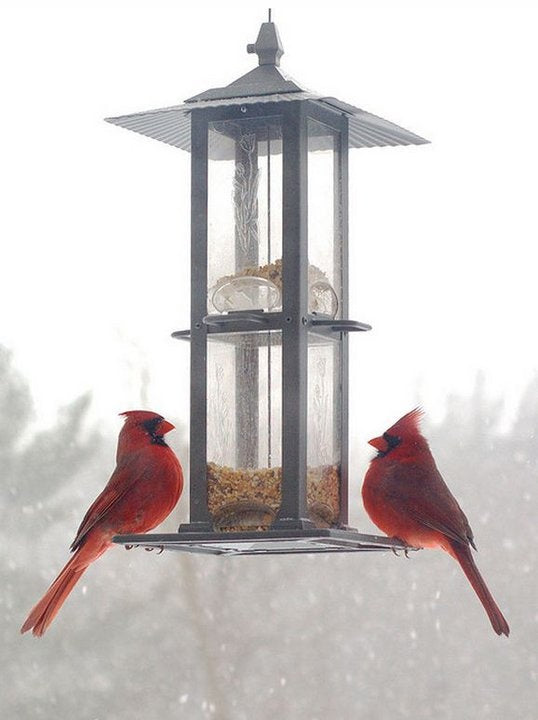Store Locator
Store Locator
A well-placed and well-stocked bird feeder is a joy for birds and bird watchers alike. But without proper care, it can become a source of disease, harming rather than benefiting the local bird population. Fortunately, bird feeder care is easy—you just have to make it a habit. Read on for tips and tricks to get the most out of your feeders.
Setting up a bird feeder is a bit like opening an outdoor restaurant. As a responsible owner, your must provide your customers with a safe and pleasant dining experience. The premises must be clean, and the food must be fresh. You don't want to be responsible for an outbreak of food poisoning among your patrons.
Diseases that are easily spread through bird feeders include:
To help prevent these and other illnesses, follow the simple precautions described below.

In bird feeding, hygiene is key. The first step toward achieving this goal is offering appropriate portions. In most cases, try to provide only as much food as the birds will eat in one or two days to prevent seed from spoiling. If left for too long, wet seed can sprout or promote bacterial growth. Moldy or decomposing seeds can make birds sick.
Give your guests ample room. If using multiple feeders, place them apart from one another. This will reduce crowding and the potential for disease transmission between sick and healthy birds.
Always use fresh, high-quality seed, and store it in a cool, dry place. Be sure to use a rodent-proof container, especially if you store your seed outdoors.
Not only will rationing your portions prevent spoilage, it will also make cleaning easier.
Every day, sweep your "restaurant" by brushing the seed hulls from the platform of the bird feeder. Clear the ground around the feeder too. Food that has fallen on the ground can attract unwanted rodents, while bird droppings and other contaminants may spread infectious bird diseases. Sweep or rake away fallen seed hulls and bird droppings on a regular basis, and dispose of appropriately.
If you have a bird bath, replace the water daily. Stale water encourages mosquito breeding and can contribute to the spread of West Nile virus.
For the same reason, avoid stagnant water from rainfall on your bird feeder platforms. Make sure bird feeder drainage holes are clear. Sticks found in the yard, a pencil or even chopsticks are perfect tools to remove clogs. Periodically moving bird feeders can also reduce the accumulation of waste in one area.
When cleaning your feeder, get rid of the old seed. If you are cleaning a tube bird feeder, knock it on the ground to dislodge stuck seed. Toss away any wet clumps. A metal spatula works well for clearing away seed hulls on table feeders and hopper feeders.
Feeders should be cleaned at least once every two weeks—more often during times of heavy use or wet weather. Wash feeders in hot soapy water, but avoid using the dishwasher.
For a more thorough cleaning, immerse your feeder in a mixture of one part bleach to nine parts water for at least three minutes. Rinse thoroughly and allow to completely dry before refilling. Regular disinfection will help keep pathogens at bay.
It's best to use gloves during these tasks. Leather gloves can be used when filling the feeder, while rubber gloves are appropriate for cleaning. Wash your hands in hot soapy water afterward.
Due to their design, hummingbird feeders require special care.
Change the nectar substitute regularly—before it gets cloudy, or about twice a week in warm weather. Frequent cleaning will help prevent mold and deadly fermentation.
Clean feeders at least once a week with a mixture of one part white vinegar to four parts water. If your feeder is very dirty, add some rice grains to the vinegar solution and shake vigorously.
Rinse your feeder at least three times with warm water and allow it to air dry completely before refilling with nectar.
Don't try to deter bees with oil or other sticky substances around the hummingbird feeding ports, as this might contaminate the nectar. If bees, ants or wasps become a problem, try moving the feeder.
Of course, watching birds is more fun than removing wet seed or bird droppings, just like eating dinner is more satisfying than doing dishes. Fortunately, there are several ways to minimize the workload.
Purchase feeders that are made of materials that are easy to clean, such as metal and plastic. Wooden bird feeders can be difficult to sanitize.
If you have more than one bird feeder, create a rotation schedule so that one is cleaned, disinfected and dried each week. That way, the chore doesn't become burdensome.
You can also reduce cleaning time by using no-waste seed mixes that contain hulled seeds and putting out only seeds that are preferred by the birds in your area. This will ensure you won’t get stuck with leftovers that can spoil and facilitate the spread of diseases.
Keep your feeder tidy, and birds will flock to your yard time and again. Cleanliness, together with prompt service, remains the most effective customer-loyalty program.